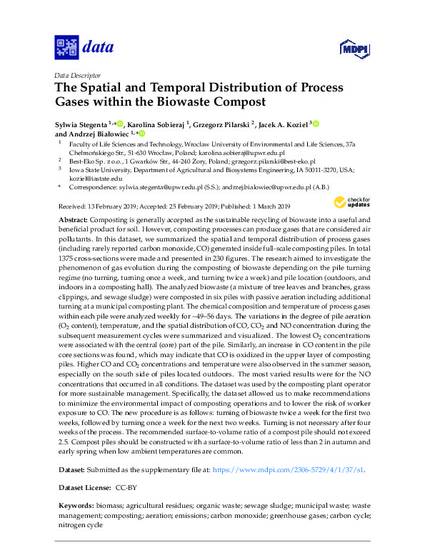
Composting is generally accepted as the sustainable recycling of biowaste into a useful and beneficial product for soil. However, composting processes can produce gases that are considered air pollutants. In this dataset, we summarized the spatial and temporal distribution of process gases (including rarely reported carbon monoxide, CO) generated inside full-scale composting piles. In total 1375 cross-sections were made and presented in 230 figures. The research aimed to investigate the phenomenon of gas evolution during the composting of biowaste depending on the pile turning regime (no turning, turning once a week, and turning twice a week) and pile location (outdoors, and indoors in a composting hall). The analyzed biowaste (a mixture of tree leaves and branches, grass clippings, and sewage sludge) were composted in six piles with passive aeration including additional turning at a municipal composting plant. The chemical composition and temperature of process gases within each pile were analyzed weekly for ~49–56 days. The variations in the degree of pile aeration (O2content), temperature, and the spatial distribution of CO, CO2 and NO concentration during the subsequent measurement cycles were summarized and visualized. The lowest O2 concentrations were associated with the central (core) part of the pile. Similarly, an increase in CO content in the pile core sections was found, which may indicate that CO is oxidized in the upper layer of composting piles. Higher CO and CO2 concentrations and temperature were also observed in the summer season, especially on the south side of piles located outdoors. The most varied results were for the NO concentrations that occurred in all conditions. The dataset was used by the composting plant operator for more sustainable management. Specifically, the dataset allowed us to make recommendations to minimize the environmental impact of composting operations and to lower the risk of worker exposure to CO. The new procedure is as follows: turning of biowaste twice a week for the first two weeks, followed by turning once a week for the next two weeks. Turning is not necessary after four weeks of the process. The recommended surface-to-volume ratio of a compost pile should not exceed 2.5. Compost piles should be constructed with a surface-to-volume ratio of less than 2 in autumn and early spring when low ambient temperatures are common.
Available at: http://works.bepress.com/jacek_koziel/254/

This article is published as Stegenta, Sylwia, Karolina Sobieraj, Grzegorz Pilarski, Jacek A. Koziel, and Andrzej Białowiec. "The Spatial and Temporal Distribution of Process Gases within the Biowaste compost." Data 4, no. 1 (2019): 37. DOI: 10.3390/data4010037. Posted with permission.